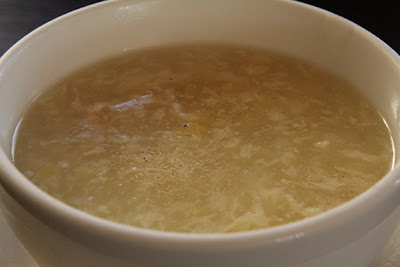reality intrudes into the life of a Wanderer. Groceries must be purchased. Oil must be changed. Hair must be cut. And laundry must be done. And, since we opted not to install a washer and dryer in the RV, the latter task means a trip to a laundromat.
But after a morning of pulling clothes from a hot dryer, I expect a reward.
Fortunately, the local laundromat is located in the same strip mall as one of our Santee (CA) favorites—Red Lotus. The restaurant is owned by the Lin family. Mr. Lin mans the wok. Mrs. Lin floats between the kitchen and dining room. And the youngest son, Vin, serves as waiter. And sometimes on weekends the two older sons, Mike and Colin, are there to help out.
Needing to do laundry shortly after our arrival in the San Diego area, we had an early opportunity to again enjoy the Lin’s take on Chinese food. And we started with an order of the Spicy Fried Calamari. We have never eaten a meal at Red Lotus that didn’t start with this dish. As best as I can figure, the calamari steak is cut into strips two to three inches long and a quarter-inch wide which are then very lightly coated in something. Rice flour? Corn starch? I don’t know. But the coating is ultra light.
The fried calamari strips are tossed with bell and jalapeno—maybe serrano—peppers and scallions that have been just barely wok-cooked at a very high heat so that they turn slightly brown. With the mix of the calamari, peppers, and scallions, the essence of each flavors the others. This may be my all-time favorite calamari presentation.
We were each ordering lunch specials and the accompanying soup was the Chicken Corn, which resembled egg flower soup with the addition of small pieces of corn. Chuck stayed with that, but Iwanted something more flavor intense and asked if, for an additional charge, I could get the hot and sour.
It was wonderful. It was full of fungus, tofu, bamboo shoots, and egg threads in a rich broth that had just the perfect balance of hot and sour.
It was worth every extra penny—all one hundred of them.
For his entrée, Chuck selected the Kung Pao chicken. This “…dish is popular both within China and in westernized Chinese cuisine in North America….The dish is believed to be named after Ding Baozhen, a late Qing Dynasty official, a one-time governor of Sichuan. His title was Gong Bao (Chinese: 宫保; pinyin: Gōng Bǎo; literally ‘palatial guardian’). The name ‘Kung Pao’ chicken is derived from this title” (wikipedia.com). In addition to the chicken and traditional peanuts, the dish contained scallions and lots and lots of mushrooms. Mine. All mine. Don’t see a photo? He must have been in a hurry to start eating and forgot to photograph his own meal.
I selected the Hunam (or Hunan) beef. Red Lotus is the only restaurant at which we have encountered this interesting preparation. Very thin slices of beef are fried until they achieve a texture that is only a few steps from beef jerky. The cooked slices of beef are then coated in a sauce containing soy, sugar, vinegar, and other elements.
The very chewy nature of the beef wouldn’t be to everyone’s taste, but I really like it.
Well, laundry day rolled around again, and it is time for my reward. To keep our streak intact, we again started with the Spicy Fried Calamari.
Instead of ordering two lunch plates, we decided to add another appetizer and then share a dinner entrée. The appetizer we chose was the Spicy Wontons. We had eaten spicy wontons in two different restaurants in Santa Fe and at each the preparation differed. At one—Wok the dumplings were floating in a spicy broth. At the other—Yummy Café—they were tossed with Chinese cabbage, carrot slivers, bean sprouts, scallions, and chopped peanuts in a soy, chile, and sesame paste sauce. Here, the steamed dumplings were bathed in an intense brown sauce that had an almost syrupy consistency. I don’t know what the sauce contained, but the dish was delicious and was almost like a salty molasses.
For the shared entrée we selected the String Beans Szechwan Style. These appeared to be a variation on the Dry Fried String Bean recipe found in my favorite Chinese cookbook—Mrs. Chiang's Szechuan Cookbook by Ellen Schrecker. I have used this book so often that most of the pages were stained with soy sauce. This is a “popular Chinese restaurant dish featuring stir-fried green beans. It comes from the Szechuan region in western China, and like many Szechuan dishes, is highly seasoned. The secret to making Chinese green beans is a cooking technique called ‘dry-frying’ (gan bian)—frying the green beans until the skin starts to ‘pucker’…” (chinesefood.about.
com). The beans turn out tender, but not mushy, and this dish can only be done with fresh and not frozen beans.
It will soon be time for laundry again, and we’ll be returning to this friendly 5.0 Addie restaurant.
To review the role of Adler, Kitty Humbug, and the Addie rating system, read the November 14, 2011 blog.
Tuesday, November 27, 2012
Subscribe to:
Post Comments (Atom)








No comments:
Post a Comment